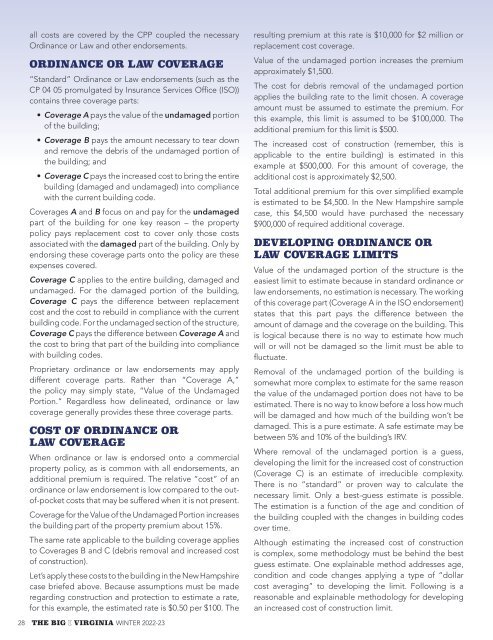The Big I Virginia Winter 2022-23
You also want an ePaper? Increase the reach of your titles
YUMPU automatically turns print PDFs into web optimized ePapers that Google loves.
all costs are covered by the CPP coupled the necessary<br />
Ordinance or Law and other endorsements.<br />
ORDINANCE OR LAW COVERAGE<br />
“Standard” Ordinance or Law endorsements (such as the<br />
CP 04 05 promulgated by Insurance Services Office (ISO))<br />
contains three coverage parts:<br />
• Coverage A pays the value of the undamaged portion<br />
of the building;<br />
• Coverage B pays the amount necessary to tear down<br />
and remove the debris of the undamaged portion of<br />
the building; and<br />
• Coverage C pays the increased cost to bring the entire<br />
building (damaged and undamaged) into compliance<br />
with the current building code.<br />
Coverages A and B focus on and pay for the undamaged<br />
part of the building for one key reason – the property<br />
policy pays replacement cost to cover only those costs<br />
associated with the damaged part of the building. Only by<br />
endorsing these coverage parts onto the policy are these<br />
expenses covered.<br />
Coverage C applies to the entire building, damaged and<br />
undamaged. For the damaged portion of the building,<br />
Coverage C pays the difference between replacement<br />
cost and the cost to rebuild in compliance with the current<br />
building code. For the undamaged section of the structure,<br />
Coverage C pays the difference between Coverage A and<br />
the cost to bring that part of the building into compliance<br />
with building codes.<br />
Proprietary ordinance or law endorsements may apply<br />
different coverage parts. Rather than “Coverage A,”<br />
the policy may simply state, “Value of the Undamaged<br />
Portion.” Regardless how delineated, ordinance or law<br />
coverage generally provides these three coverage parts.<br />
COST OF ORDINANCE OR<br />
LAW COVERAGE<br />
When ordinance or law is endorsed onto a commercial<br />
property policy, as is common with all endorsements, an<br />
additional premium is required. <strong>The</strong> relative “cost” of an<br />
ordinance or law endorsement is low compared to the outof-pocket<br />
costs that may be suffered when it is not present.<br />
Coverage for the Value of the Undamaged Portion increases<br />
the building part of the property premium about 15%.<br />
<strong>The</strong> same rate applicable to the building coverage applies<br />
to Coverages B and C (debris removal and increased cost<br />
of construction).<br />
Let’s apply these costs to the building in the New Hampshire<br />
case briefed above. Because assumptions must be made<br />
regarding construction and protection to estimate a rate,<br />
for this example, the estimated rate is $0.50 per $100. <strong>The</strong><br />
resulting premium at this rate is $10,000 for $2 million or<br />
replacement cost coverage.<br />
Value of the undamaged portion increases the premium<br />
approximately $1,500.<br />
<strong>The</strong> cost for debris removal of the undamaged portion<br />
applies the building rate to the limit chosen. A coverage<br />
amount must be assumed to estimate the premium. For<br />
this example, this limit is assumed to be $100,000. <strong>The</strong><br />
additional premium for this limit is $500.<br />
<strong>The</strong> increased cost of construction (remember, this is<br />
applicable to the entire building) is estimated in this<br />
example at $500,000. For this amount of coverage, the<br />
additional cost is approximately $2,500.<br />
Total additional premium for this over simplified example<br />
is estimated to be $4,500. In the New Hampshire sample<br />
case, this $4,500 would have purchased the necessary<br />
$900,000 of required additional coverage.<br />
DEVELOPING ORDINANCE OR<br />
LAW COVERAGE LIMITS<br />
Value of the undamaged portion of the structure is the<br />
easiest limit to estimate because in standard ordinance or<br />
law endorsements, no estimation is necessary. <strong>The</strong> working<br />
of this coverage part (Coverage A in the ISO endorsement)<br />
states that this part pays the difference between the<br />
amount of damage and the coverage on the building. This<br />
is logical because there is no way to estimate how much<br />
will or will not be damaged so the limit must be able to<br />
fluctuate.<br />
Removal of the undamaged portion of the building is<br />
somewhat more complex to estimate for the same reason<br />
the value of the undamaged portion does not have to be<br />
estimated. <strong>The</strong>re is no way to know before a loss how much<br />
will be damaged and how much of the building won’t be<br />
damaged. This is a pure estimate. A safe estimate may be<br />
between 5% and 10% of the building’s IRV.<br />
Where removal of the undamaged portion is a guess,<br />
developing the limit for the increased cost of construction<br />
(Coverage C) is an estimate of irreducible complexity.<br />
<strong>The</strong>re is no “standard” or proven way to calculate the<br />
necessary limit. Only a best-guess estimate is possible.<br />
<strong>The</strong> estimation is a function of the age and condition of<br />
the building coupled with the changes in building codes<br />
over time.<br />
Although estimating the increased cost of construction<br />
is complex, some methodology must be behind the best<br />
guess estimate. One explainable method addresses age,<br />
condition and code changes applying a type of “dollar<br />
cost averaging” to developing the limit. Following is a<br />
reasonable and explainable methodology for developing<br />
an increased cost of construction limit.<br />
28 THE BIG I VIRGINIA WINTER <strong>2022</strong>-<strong>23</strong>

















